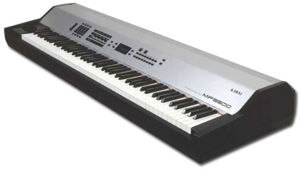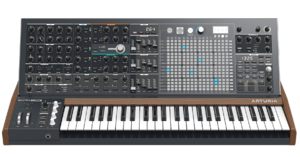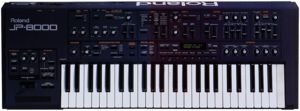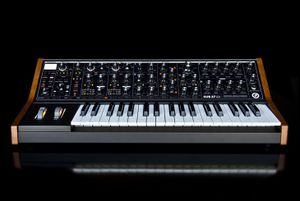Keyboards
Bellamy & Pianos
The piano was the first instrument Bellamy really played: "I didn’t have any lessons, and though I tinkered with it since I was five, I didn’t really get interested until I was ten or 11. I used to work on my left hand to “What’d I Say” (Ray Charles) in sort of this boogie-woogie style. I spent ages working that out, practicing the left hand doing one thing and trying to do chords with the right hand."
Since the recording of Sunburn, the majority of Muse's songs have been drafted on piano by Bellamy: "I find it easy to find interesting chords on the piano. Especially because on a lot of stuff we do, the guitar and bass are harmonizing.", "Even a song like Stockholm Syndrome was written on piano."
However, on an early TV performance of Sunburn, the band brought in someone else to play the piano part and Bellamy played the guitar (although he later complained that the player was rubbish and got the notes wrong), as Bellamy didn't learn to sing whilst playing the keyboard until the end of the Showbiz era. This was also when the band began putting an emphasis on more complex, classically-influenced piano-based tracks such as Space Dementia.
Bellamy's Live Keyboard Rig
During the Origin of Symmetry tour, Bellamy used Korg SG or Yamaha P80 stage pianos, or a Roland Juno-60 synthesizer. This allowed the acoustic piano sounds and electronic/synth sounds (e.g. arpeggios in Space Dementia's chorus) to be routed to their own individual amplifiers.
On the Absolution tour, he used a Kawai MP9500 stage piano. It was mounted on a metal mesh podium nicknamed "The Dalek" which featured LED displays which could be synchronized to the MIDI output from the keyboard and the stage's visuals, allowing the piano to output it's own lightshow; A system which Matt still has in it's modded grand piano housing, used live. For synth sounds two Roland JP-8000 synthesizers were controlled using MIDI from the Kawai Keyboard and run through Fender Deville Amps to add color & dirt to the sound.
Since the release of Black Holes and Revelations, Morgan Nicholls has become a staple fixture of live performances, with his own keyboard rig, used to replicate the synthesisers used on albums, without the need for excessive backing tracks (see below). In addition, Bellamy has updated his own live setup with a Kawai MP-8 digital stage piano mounted, during the first tour in support of Black Holes and Revelations, in a white, custom made upright piano case built by Vale Pianos. Bellamy sat at this to play piano-based songs such as New Born (intro), Citizen Erased (coda), Butterflies & Hurricanes (solo), as well as Sunburn, Hoodoo, Soldier's Poem and Feeling Good. Since the May 2007 gig at Rockhal, Luxembourg, the digital piano's case has once again been replaced, this time by a black grand piano shell with a transparent acrylic lid. As noted above, inside the wing of the piano are MIDI-controlled light bars, producing an effect last seen on "The Dalek", but being reflected on the grand piano's transparent lid, making the light squares from the light bars look like holograms. It is important to note that this is not a real grand piano, but the same stage piano as used before, merely in a new case, thus having place in the shell for lights.
Since the start of the Resistance tour, Matt has used both the upright and grand pianos, while for the live performances of Neutron Star Collision (Love Is Forever), Bellamy used a Kawai ES-6, mounted on a movable wireless keyborad stand, allowing him to play the piano while standing up with a guitar infront of his main microphone.
For The 2nd Law and Drones Tours, the black grand piano case and the white upright case were refinished in chrome/silver, with the chrome grand first being seen at the London Olympic Closing Ceremony and the chrome upright seen on the Unsustainable stadium tour. Since 2017 started, Matt has seemingly ceased using the grand piano live and instead uses just the upright one.
For The Simulation Theory Tour in 2019, the upright piano case was replaced yet again, this time with a new, more simplistic, black case with large openings cut through the main shell, and a lower back, to accommodate for better reach to a synth unit being placed on top for Algorithm. The shell features colour-changing LED's around the edges - matching the albums 80s and neon art style.
Synthesizers
In an interview with Keyboard Magazine Bellamy said that he's always had a liking for arpeggios since his first keyboard - a Roland Juno 60, which had a built in arpeggiator. This was first featured in Bliss and Screenager, and has been even more prominent on later albums, including Black Holes and Revelations. This was the first album to feature Buchla 200e modular synthesizer, which was purchased during the Miraval sessions in 2005, and has been used prominently for most arpeggio parts on future albums.
Between the 2006 and 2012 tours, in live performances, these arpeggios were played using MIDI backing tracks via a MiniMoog Voyager RME. When Nicholls (or Howard, during the BH&R tour) has nothing else to play, they adjust the filter control of the synths to add color to the arpeggios. In an XFM Exposure Interview, it became clear that it is Howard who has spearheaded the increased use of modular synthesisers on Black Holes and Revelations - he liked the idea of recording a whole disc of synthesised music. It is Howard who also controlled the synth's filter during live performances of Take a Bow, when Morgan Nicholls is not on stage. He has used a variety of synths including a Buchla, another MiniMoog Voyager (e.g Shepherd's Bush) and a bespoke modular sythesizer by Macbeth Studio Systems (e.g Reading Festival 2006); photographs can be seen on their web-site), however Howard ditched his modular synths used for live since The Resistance tour, leaving all synth parts to be played by Morgan.
During The Resistance tour, Muse started throwing in more on-stage wireless MIDI controllers, such as a Manson Keytar/Manson Keytarcaster, used for Undisclosed Desires, controlling synths and/or soft synths on off-stage units and laptops. Although, wireless MIDI is now more prominently used by Chris ever since the 2012 tour, starting with bass guitars having a built-in Misa Kitara and even a MIDI keyboard (see below).
During the Simulaiton Theory tour in 2018 and 2019, Bellamy ventured even more into the Arturia synth teritory; Including an Arturia MatrixBrute synth to acompany his piano, using it to play the lead synth in Algorithm. This is the first time Bellamy really used a lower piano shell to house a synth on top. In an interview with Matt's guitar tech in 2019, it was revealed that for the Simulation Theory World Tour, Matt's tech, alongside MIND Music Labs, Fishman and Arturia, built a custom-made Arturia Prophet V soft-synth system into his guitar. Bellamy has (so far) used the synth guitar during The Dark Side's solo.
For the Will of the People 2022 Festivals Tour, Bellamy's Power Glove, which used to be a wardrobe prop for the Simulation Theory Tour, was modified to house an iPhone/smartphone. The phone is used as a device to run a virtual synth via an app called "Noise". It is used on Behold the Glove and Uprising..
Wolstenholme's keyboards
During the Absolution tour Chris occasionally used a Roland JP-8000 to play the intro to Time Is Running Out (early performances) and the string part of Blackout for which he also played Bellamy's Kawai.
Wolstenholme also played a foot-controlled synthesizer pedal in some songs, for example the pad sound in Sing for Absolution or the bass in Unintended, while playing acoustic guitar. The foot pedals he used were the Moog Taurus 1 (OoS tours) and the Roland PK-5 (Absolution tours). During the BH&R tour, Chris occassionally played the Kaoss pad noise on New Born, as seen on the H.A.A.R.P. DVD.
On The Resistance tour, Chris ditched playing any keyboards or synth almost completely, while for The 2nd Law tour, he, allthough not technically a keyboard, got himself a Status Kitara Doubleneck Bass, used for Madness, later replaced with a Status Kitara Doubleneck Bass Mk2, which was also used for Dig Down. For the Simulation Theory tour, Chris has got himself an custom Status Keyboard Bass, which includes, as the name implies, a keyboard built into the bass. For both the Kitara bass and the Keyboard bass, the keyboard part is connected via a wireless MIDI unit to an off-stage laptop, running the synth engine (in Chris' case, MainStage).
Nicholls' gear
The range of synthesiser parts used in Absolution meant that during the tour in support of it, the band began to use backing tracks in order to perform the songs in their entire nature. However, in the time leading up to the release of Black Holes and Revelations, Bellamy discussed how they had, as a band, decided to use a fourth live member from now on, to reduce the need for such backing tracks. This man is Morgan Nicholls, famed multi-instrumentalist. As befits a man of his enigma, Nicholls's gear remains something of mystery. His two keyboards during the BH&R era, when he started touring with Muse, could be identified as a Clavia Nord Modular G2 (responsible for the band's vocoder effects), and a Novation ReMOTE SL 61 MIDI controller. His rack contained a MiniMoog Voyager RME, an Electrix Filter Factory and an Electrix Mo-Fx MK2. He was also using a Damage Control TimeLine delay unit, and a Korg KP3 Kaoss Pad, which he is known for using to this day. Furthermore he was (and presumably still is) using Logic and software instruments running any backing tracks when he's playing live. During The Resistance tour, and the early The 2nd Law tour, the two keyboard setup was ditched completely in favour of just one MIDI keyboard, the Kawai MP-6, with his racks placed on a custom keyboard mount infront of him, instead of being on a rack unit behind him. The KP3, aswell as most of the rack effects units were kept from the previous tours.
For The 2nd Law tour and the Drones tour, the on-stage computer was ditched from the stage itself, and Morgan instead opted for an iPad-based on-stage control system, using two iPads running Liine's Lemur software, which is controlling the MainStage software for keyboard sounds. The two-keyboard setup was back once again; Using the Doepfer D3M as his main keyboard in combination with the Novation Mininova for vocoder parts.
During the Drones tour, the Mininova was relpaced with a Moog Sub37, which appears to be used through MIDI for arpeggio parts, aswell as additional synth parts and some filtering. During the Simulation Theory tour, this setup has remained quite similar, with the iPad system ditched and his laptop back on the stage. Alike Matt and Chris, Morgan uses a Kemper Profiling Amplifier (white) for touring. It is placed in a rack, beside Chris' racks.
References
http://www.keyboardmag.com/story.asp?sectioncode=29&storycode=9057
http://www.novationmusic.com/artist_community/international/muse/
http://www.tonastodin.is/gr_myndir/piano/kawai/KawaiNews_0610.pdf



